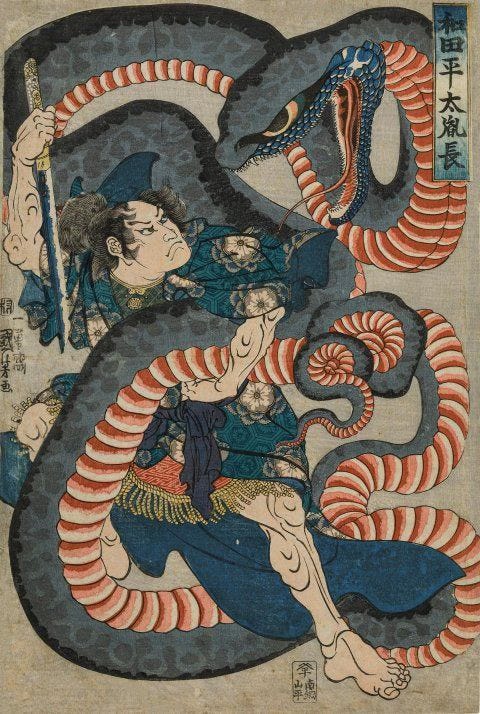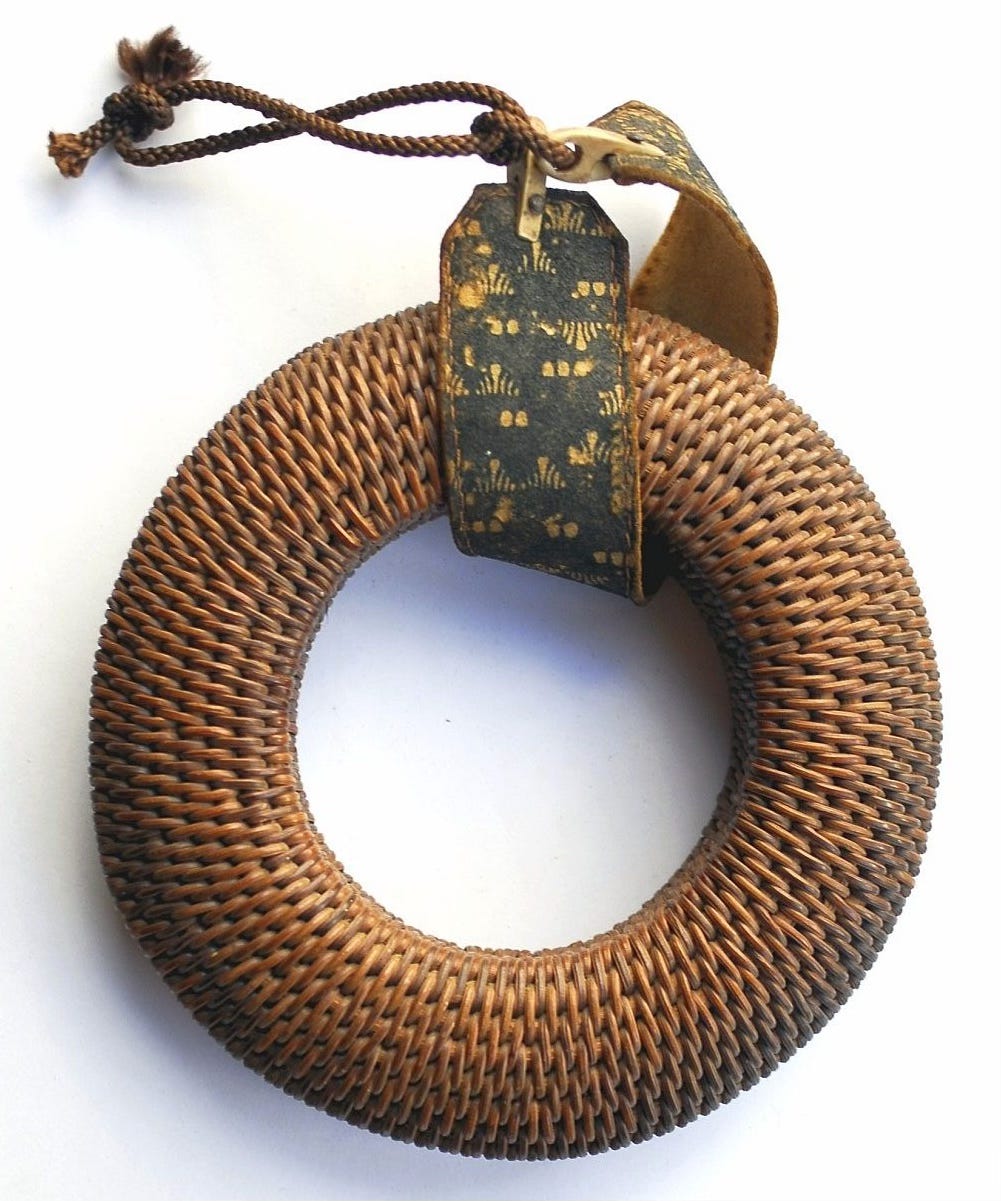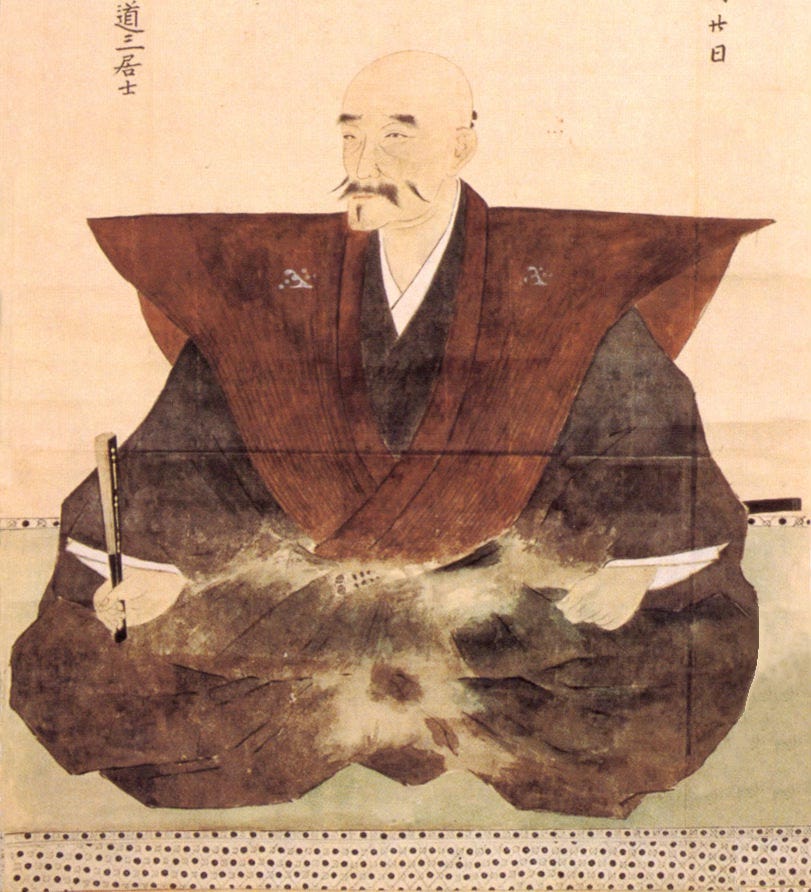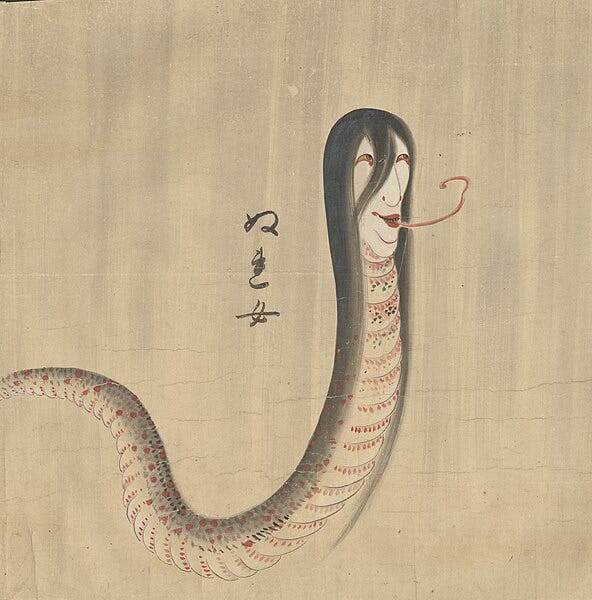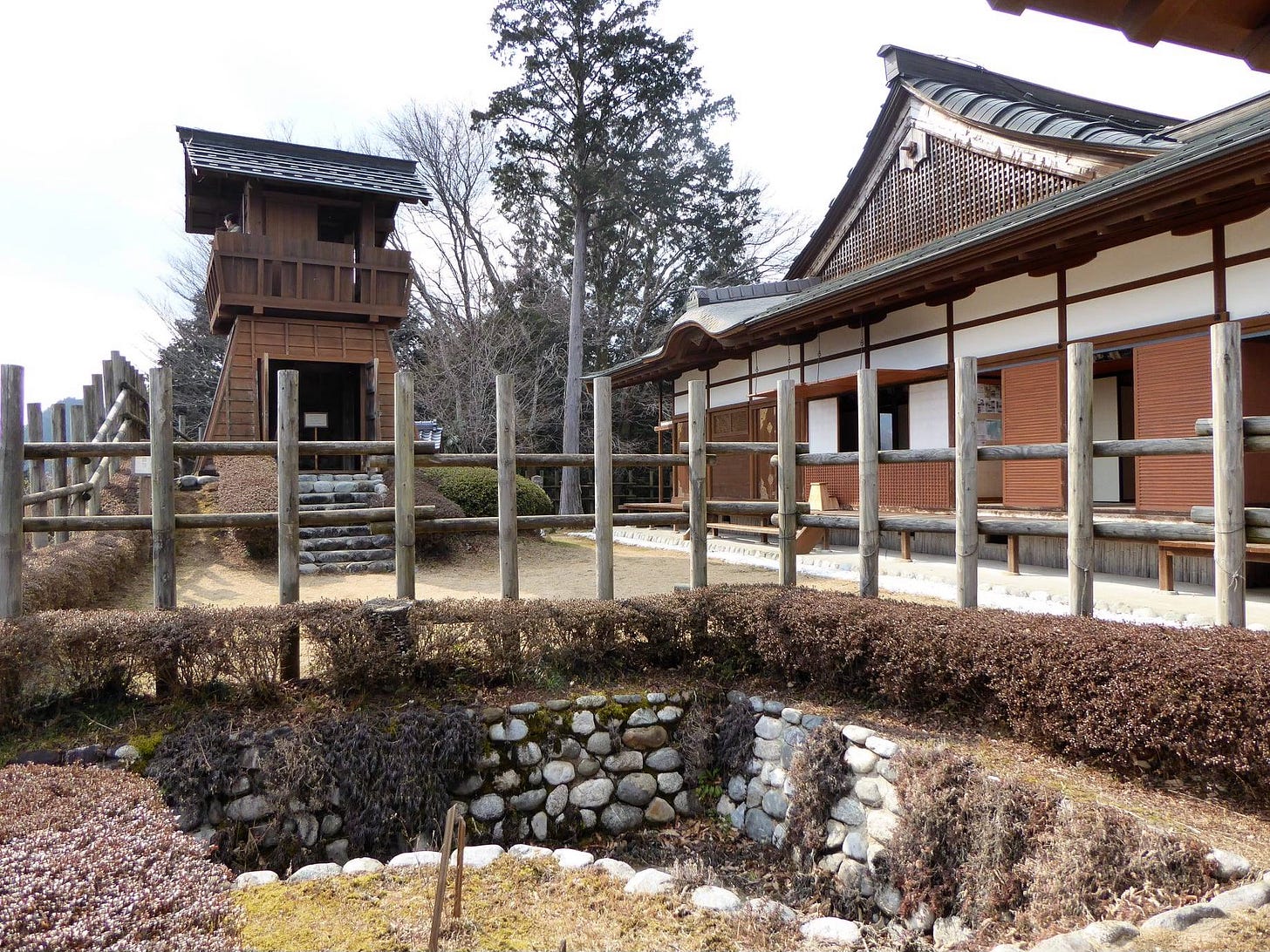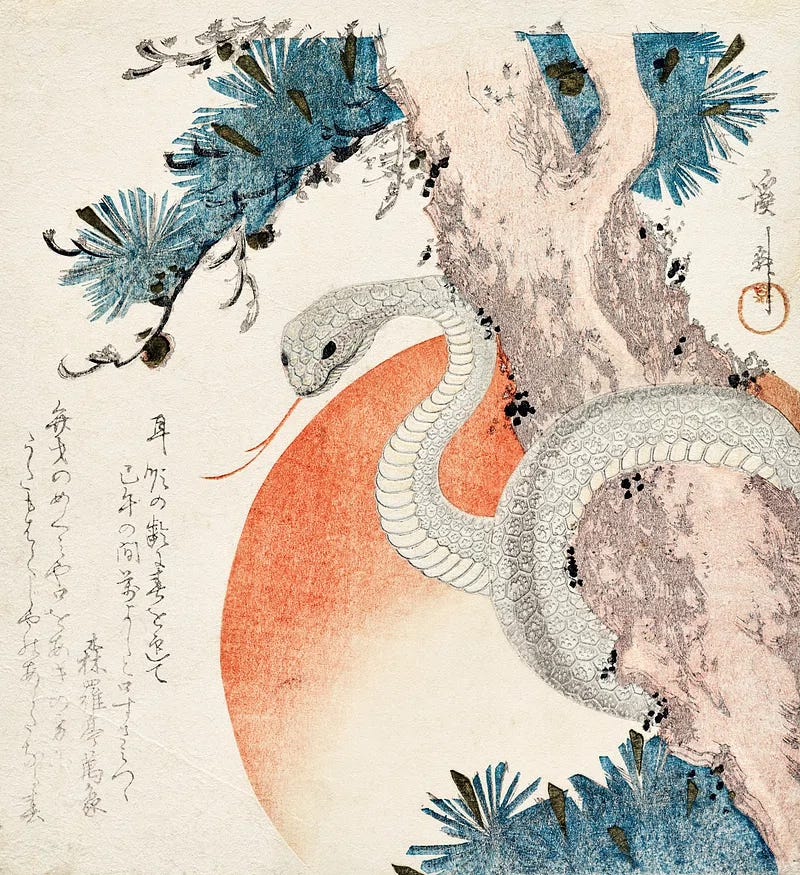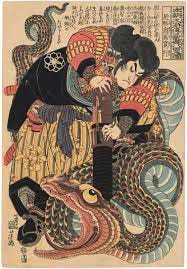2025 is the year of the snake — the most mysterious animal of the zodiac. People born in the year of the Snake are said to be secretive and cautious.
Giant snakes have been a common theme in Japanese myths and legends for centuries, and serve as symbols of wisdom, protection, and spiritual significance. They appear in tales of the gods, heroes, and mythical beings, showing the intricate relationship between humans and the environment. In Japan, snakes are both feared and revered as they embody the forces of life and death, renewal and destruction, and as such are entangled within Japanese beliefs, folklore, and cultural symbolism.
The Snake Eye Crest
The most common surname in Japan’s third largest, centrally located city of Nagoya is "Kato". Many members of the Kato family use variations of the wisteria crest as their family crest, including the descending wisteria, the ascending wisteria, the round wisteria, etc., but there is a rather rare family crest used by various Kato clans in the central Japan area. It is a thick circle, known as the Jyanome, the snake eye crest!
The snake eye crest was originally a crest representing the tsurumaki, the disc like spool that holds spare bow strings. It became a family crest with a martial meaning because of its simple design and military equipment origins. From the late Sengoku period it became known as Jyanome, snake eye crest, because it apparently resembles a snake's eye. This family crest is quite rare, used exclusively in what is now Aichi, Gifu, Shiga, and Shizuoka Prefectures. It was used by the Kato, Toda, Horie, Iitomi, Hosokawa, Matsudaira, Ishikawa, Kyogoku, Hiramatsu, Hanabusa, and Hayashida warrior families. Sengoku warlords who used this family crest include Kato Kiyomasa, Kato Yoshiaki, Hanabusa Masayuki, Ishikawa Kazumasa, and Hosokawa Okimoto.
Incidentally, the sewing machine company, Janome was also named "snake's eye." In 1935 when the newer, round bobbin system was starting to replace the traditional long shuttle. The new round bobbin looked like a snake's eye, and so Janome was chosen as the company's name.
47 Snakes
Japan has 47 different snake species, but only four of them are considered dangerous.
The yamakagashi is found across much of mainland Japan and the Okinawan Islands. They are dark brown or olive snakes with orange spots along the top third of their body, and white or cream undersides. Yamakagashi get their venom from their diets of poisonous frogs. After eating poisonous toads, the snakes store the toxins in special glands near the back of their mouth and re-use them for defence against predators.
Mamushi are the most dangerous snakes in Japan. Around 2,000-4,000 people are bitten annually. Recovery involves at least a week of intensive hospital care, but an average of ten people die each year even with proper treatment.
Mamushi go by various names, including the Japanese moccasin, and Japanese pit viper amongst others. These snakes can be found across Japan, and are either pale gray, rust brown, or yellow-brown with irregular splotches and evenly spaced banding down their backs. Their heads are generally wider, triangular and flatter than other snakes, with darker eyes and distinct pits, marking them as pit vipers.
The Mino no Mamushi , the Viper of Mino, was the nickname given to Warlord Saito Dosan, father-in-law of Oda Nobunaga and master of what became known as Gifu Castle. Saito Dosan was said to have been as vicious and as dangerous as a venomous viper, and was therefore known the Mamushi of Mino.
In the 11th century story of Anchin and Kiyohime, Princess Kiyo (Kiyohime) fell in love with Anchin, a young Buddhist monk, but when he rejected her advances, enraged she transformed into a serpent, before killing him as he hid in Wakayama’s Dojo-ji Temple’s bell. Nure-onna, literally "wet woman" is a Japanese apparition with the head of a woman and the body of a snake. They are also seen at sea but are known as nure-yomejo. They are often said to devour humans.
Lake Onuma Snake
Legends tell of a great serpent that lived in Lake Onuma in Nagano Prefecture. Every spring, the snake would transform into a handsome young warrior and go view the cherry blossoms in the Shiga Highlands. One year, he spied a beautiful young woman under the blossoms. The woman was Princess Kuro, daughter of the lord of Shinano Takanashi Masamori. The princess had seen the young man watching her and soon fell in love.
The young man later visited the castle of Lord Takanashi Masamori, and introduced himself as the guardian deity of the region, the great snake of Lake Onuma, and asked Lord Masamori for permission to marry his daughter. Lord Masamori refused to give his daughter to someone who was not human.
Despite this, the young man refused to give up, returning every day with the same request.
Each time Masamori refused to allow his daughter to marry a snake, and so he planned to kill it, so it would leave his daughter alone. One day the expert horseman of a lord struck a bargain with the snake saying, “If you can beat me on horseback to complete seven laps around the castle, you may marry Princess Kuro.” The young man accepted the challenge, and days later, returned to the castle for the race.
Meanwhile, Lord Masamori had set traps, hiding numerous razor-sharp swords in the long grass and bushes around the castle.
The snake, still in the form of a young man turned up at the castle at the designated time, and the race begun. As expected, the young man could not keep up with the lord and had to transform himself back into a snake to keep up. The swords set up in the grass around the castle cut into the snakes’ body, but he did not give up. By the time they had completed their seven laps, the snake had been almost shredded, and upon narrowly beating the lord across the finishing line, collapsed from loss of blood.
Sometime later, the snake regained consciousness, and finding itself alone, realized he’d been tricked. In anger, the snake gathered family, servants, and clan members —the spirits of the Shiga Highlands — and together they summoned a great rainstorm. For days, torrential rains fell and Lake Onuma soon overflowed, washing away villages, flooding the fields, no one was able to escape the destruction. However, Lord Masamori’s castle was located high enough to escape the flood waters.
Princess Kuro watched from the castle as the floods washed away the entire region. Realizing that only she had the power to stop the disaster, she made her way to Lake Onuma and threw herself into the floodwaters, never to be seen again. When the snake heard what had happened, it immediately broke the storm and caused the floods to recede. A small shrine dedicated to the snake sits near Lake Onuma, and the great snake and his lost love, Princess Kuro, are still celebrated in a festival held every August.
Snake Head Castle
Damine Castle, also known as Jazuga or Snake Head Castle was built circa 1470 on a hill overlooking the village of Damine in north eastern Aichi Prefecture. It was constructed as a residence for the Suganuma clan, former retainers to the Imagawa clan, and then following the Imagawa defeat at the Battle of Okehazama, the Tokugawa clan. In the mid 1500’s Takeda Shingen began encroaching on the Tokugawa owned Mikawa lands, and the Suganuma clan again changed allegiances to that of the Takeda.
Damine Castle covers an area about 200m each side. Dry moats and earthen embankments surrounded the western facing front of the castle, with its many terraced kuruwa or baileys. The uppermost bailey, the Honmaru, was oval shaped and contained the lord’s residence and working area, a watchtower, retainer’s quarters, guard houses, possibly stables and kitchen facilities. The eastern facing rear of the castle was not so heavily fortified, as it was protected by the naturally steep cliffs along the Toyokawa River far below.
In the 1575 Battle of Nagashino, Suganuma Sadatada had served Takeda Katsuyori during the siege of Nagashino, but suffered greatly during the actual battle itself. Katsuyori himself managed to flee from the battlefield and accompanied by Sadatada, sought refuge at Sadatada’s Damine Castle. Upon their arrival, they discovered that Sadatada’s uncle Suganuma Sadanao supported by clan vassal Imaizumi Dozen had since defected to the Oda clan, and shut the gates on Sadatada and Katsuyori. They were then forced to escape to Busetsu Castle, about 20km away.
Don’t Play with Snakes, They Can Turn and Bite You!
In revenge for this act of treason, Sadatada faked his own death, thus relaxing security at the castle. Early one morning, Sadatada and an army of loyal followers attacked the castle, capturing the fortress along with his uncle, Sadanao and Imaizumi Dozen. Both were executed in a public area near the castle along with 100 other traitors. Less than six years later, the Takeda clan were ruined. Fearing the growing strength of the Tokugawa, Sadatada left Damine Castle and fled to Ina in modern-day southern Nagano Prefecture. Damine was soon claimed by the Tokugawa who established another branch of the Suganuma clan, and trusted vassals, as castellan. The castle was abandoned during the Edo Period, and the ruins remained in relatively untouched condition. It was authentically rebuilt almost 30 years ago.
White Snakes
A huge snake is said to inhabit the largest well at Maruoka Castle, and if the castle ever came under attack, the snake was said to emit a thick fog that would protect the castle.
A rare, entirely albino population of white rat snakes can be found around Iwakuni, birthplace of Miyamoto Musashi’s rival, Sasaki Kojiro in Yamaguchi Prefecture. These harmless white snakes are also famed for being auspicious, and are seen as messengers of the Goddess, Benzaiten. And there is even a story about a giant snake and Oda Nobunaga, the lord of Owari.
Nobunaga and the Snake In The Lake
The legend goes that a few kilometers north of Nagoya Castle, there is a large lake where a huge snake, said to be big enough to eat a person whole, lived. Apparently, many locals had mysteriously disappeared, and villagers believed the snake had taken them, and so they were afraid of the pond and the snake and refused to go near it. When Oda Nobunaga heard the story of the giant snake, he decided to do something about it. Nobunaga visited the pond with a small retinue to search for the snake and to calm the villagers’ fears.
First, Nobunaga ordered the villagers to empty the 60-meter-wide lake and formed a bucket brigade, but little progress was made. Stripped bare to the waist and with a dagger clenched in his teeth, Nobunaga himself swam the lake in search of the giant snake. Next, Nobunaga called for his best swimmers, who also dived and surfaced like cormorants searching for prey, but all in vain.
Eventually, after ten days of trying to empty the lake and diving into it, Nobunaga announced that there was no longer any giant snake in the lake and returned to Nagoya Castle.
The lake still exists today and has been known as Jaike since Nobunaga's time. The lake and the adjacent Jaike Shrine are located within a park in Nagoya’s Nishi Ward.
So there you have it, some historical samurai stories related to snakes, fitting for the start of a new Year of the Snake. …Fangs again for following!




